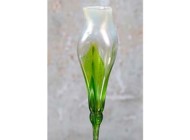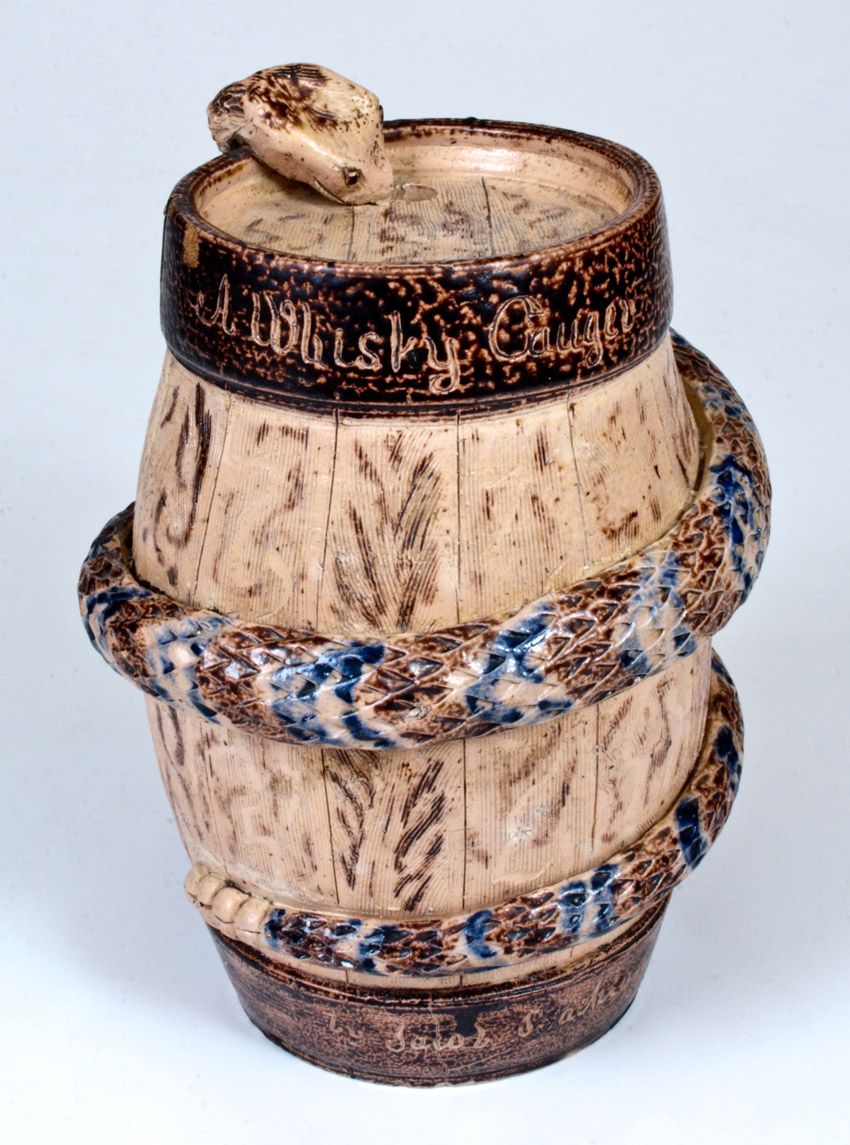
This rare stoneware snake temperance keg by Jacob Bachley, Texarkana, Ark., circa 1880, was the top lot at $37,950.
Review by W.A. Demers;
Photos Courtesy of Crocker Farm, Inc
SPARKS, MD. — A possibly unique stoneware temperance rundlet with applied rattlesnake and profuse cobalt and manganese decoration was the top lot at Crocker Farm’s March 19 stoneware and redware auction. Inscribed “A Whiskey Gauger,” and signed by Jacob Bachley, the Texarkana, Ark., circa 1880, wheel-thrown keg went to a private collector from the Texarkana area for $37,950, besting its $15/25,000 estimate. An area museum was the underbidder. The keg, which had been featured in a segment of the PBS television series Antiques Roadshow, had been used for many years as a doorstop by an Arkansas family, and presumably had been acquired directly from the potter by the consignor’s great-grandmother.
With incised surface simulating wooden staves, each end with faux iron bands, the body of the keg is seemingly constricted by a hand-modeled and applied clay rattlesnake. The snake features life-like scaling created with a triangular stylus, a well-defined rattle and a diamond-shaped head with poison glands and beaded clay eyes.
It was the whiskey gauger’s responsibility in Nineteenth Century America to measure a distillery’s production, but even more important to collect excise taxes on the amount of whiskey produced. In 1794, according to Crocker Farm’s catalog notes, a failure by Pennsylvania distilleries to pay whiskey excise taxes led President George Washington to deploy troops in the famous “Whiskey Rebellion.” This tax was later repealed, only to reemerge in 1862 through the Internal Revenue Act, which created the position of “whiskey gauger.”
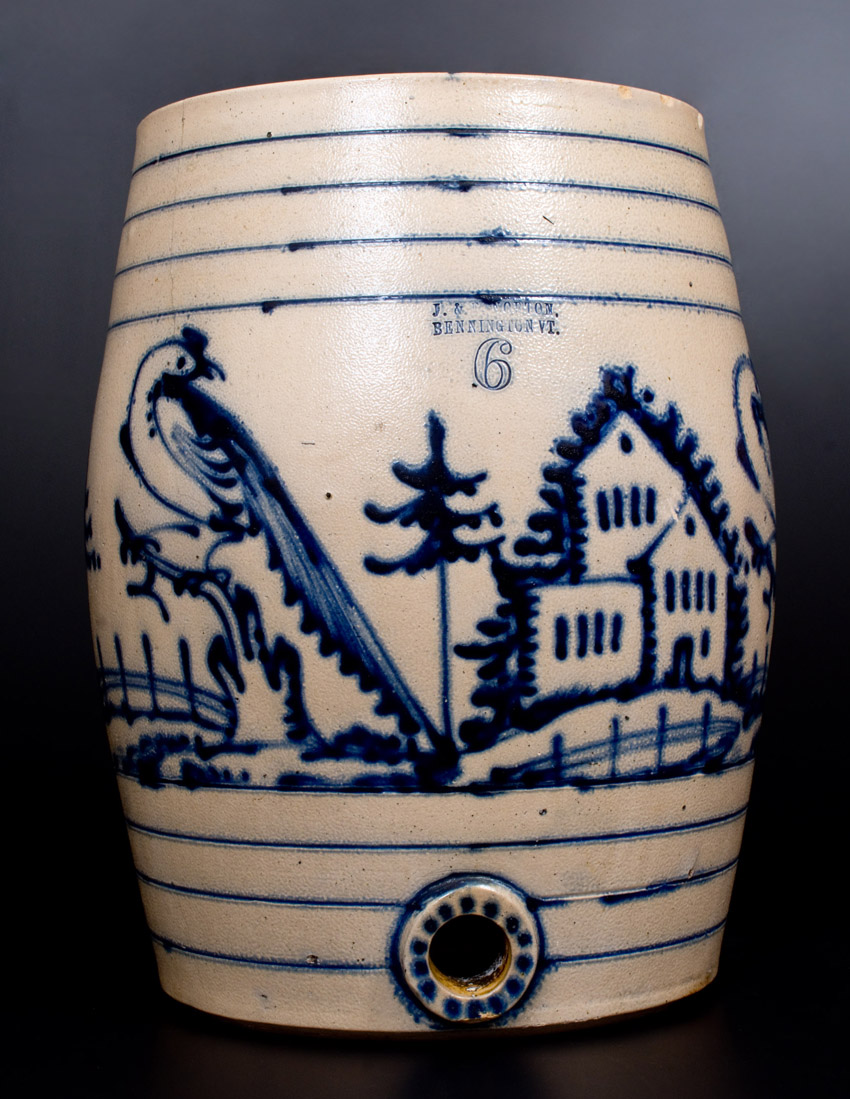
J.&E. Norton / Bennington, Vt., stoneware water cooler with four pheasants and house sold for $34,500.
The Jacob Bachley name adds great importance to an otherwise outstanding ceramic work. It transforms the piece into a rosetta stone of sorts, as it reveals the identity of the infamous Texarkana “Pottery Man,” who produced pig bottles and snake jugs in the Anna style. A small number of pieces bearing the inscription “by Texarkana Pottery” and one bearing the signature “by Jacob” are documented, but previous attempts by those interested in Anna Pottery to conclusively identify the origin of these examples have been met with failure.
“From perspectives of American folk art as well as ceramic history, this object ranks among the greatest works we have ever handled,” said Crocker Farm’s Tony Zipp.
Crocker Farm traditionally starts its sales with a bang — and this one was no exception, as the first lot out of the gate was surpassed in price only by the Texarkana Snake keg. Fetching $34,500, above its high estimate, was a monumental 6-gallon stoneware water cooler, circa 1855, with a cobalt pastoral scene featuring a pheasant on a stump and a house motif. It was stamped “J.&E. Norton / Bennington, Vt.” A catalog note on this lot described it as “arguably the finest of three Norton coolers from this period we have offered.” Fresh to the market, it had been purchased by the consignor decades ago.
From the cool blue hues of stoneware to the fiery tones of decorated redware, the third highest price in the sale was achieved by a rare Alamance County, N.C., redware sugar jar, circa 1790–1810, that realized $28,750 against a $6/10,000 estimate. With profuse three-color slip decoration, the jar was alive with classic, early North Carolina motifs in green, cream and brown slip with slip-trailed daisies and lines. Similar examples can be seen in the collection of Colonial Williamsburg, the Henry Ford Museum and the Barnes Foundation.
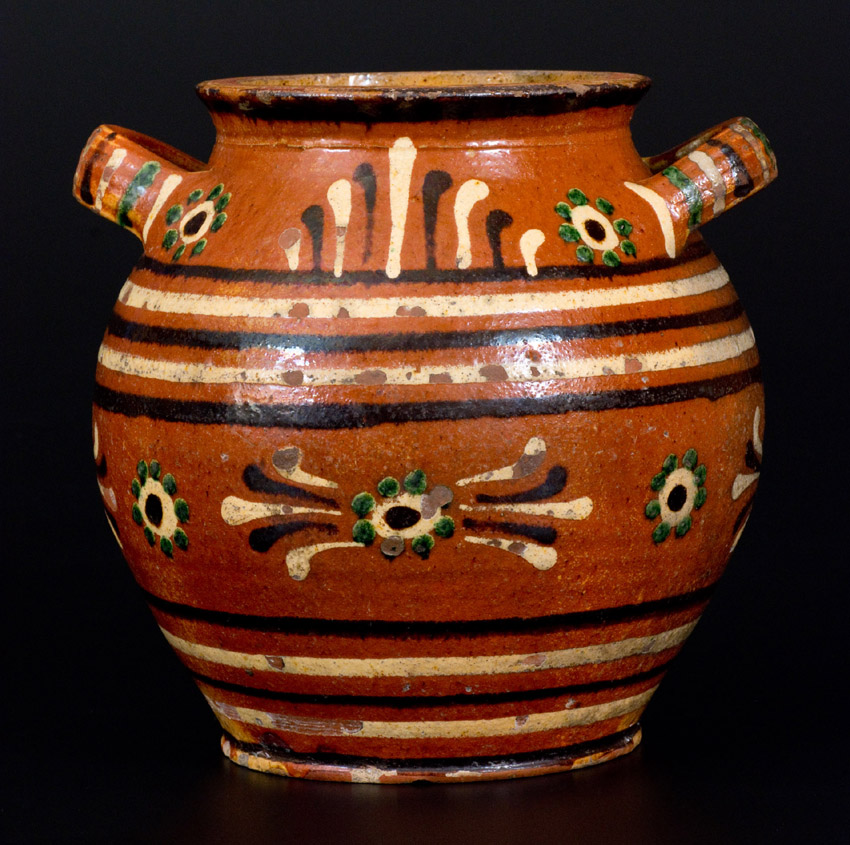
A rare Alamance County, N.C., redware sugar jar with profuse three-color slip decoration was bid to $28,750.
One of the finest Morgantown, W.Va., crocks depicting people the firm has ever offered, a rare 3-gallon stoneware example attributed to David Greenland Thompson, circa 1860, leapt to more than two times its high estimate to finish at $24,150. It was one of a recently surfaced selection of West Virginia, western Pennsylvania and Ohio stoneware that had descended in the family of Ohio antiques dealer Clark Garrett. Cylindrical in shape and with a tooled shoulder and distinctive extruded handles, the crock was decorated on the front with a large figural design of a woman wearing a hat with flowing train. Dimensionality of her apron, hat and collar was achieved with additional layers of brushed cobalt and trees with two rows of sponged leaves appearing to the left and right of her.
Just three lots later, another figural stoneware crock from the Garrett family collection, this one a 4-gallon example, circa 1865, from Uniontown, Penn., took $20,700, twice its high estimate. The figures — two in this case — were more minimalist than the Morgantown crock, yet the Uniontown characteristics as seen in the figures and trumpet flower decoration made it a highly desirable piece.
An Eiler & Sunshine, East Birmingham, Penn., stoneware pedestal water cooler, circa 1858–62, was possibly unique, the catalog noting that it was, to the firm’s knowledge, the only signed example from the partnership of potters Philip Eiler and Henry Sunshine. Their collaboration was brief, lasting only from 1858 to 1862. Bid to $19,550 the profusely cobalt-decorated piece with a riot of brushed tulips emanating from its bunghole was also from the Garrett family collection, so it had been essentially unknown to the collecting community for several years.
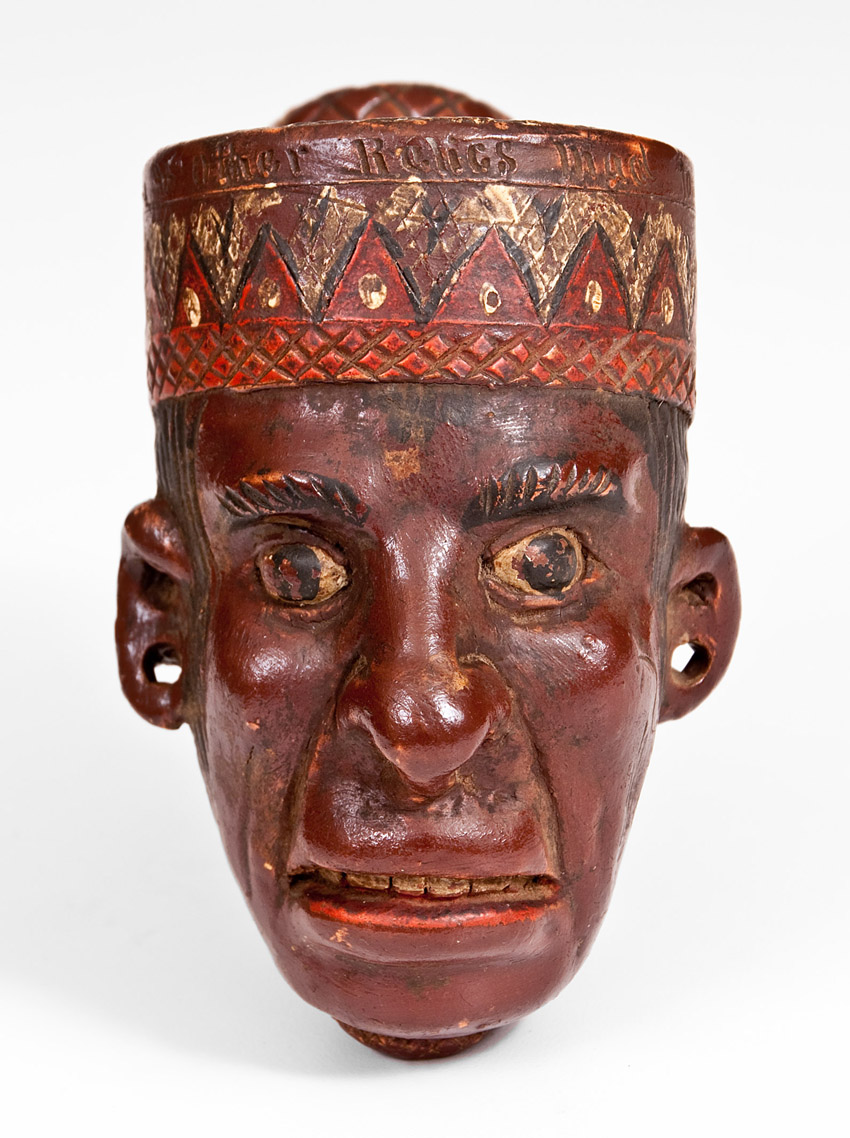
Exemplifying typical Kirkpatrick whimsy, this “made to order relic” Anna Pottery Indian head stoneware peace pipe, dated 1873, garnered $12,650.
Redware animal forms animate any pottery sale, and for this one, a rare Moravian bear bottle attributed to Rudolph Christ, Salem, N.C., circa 1810–30, stole the hearts of bidders, who prodded the beast from its $4/6,000 estimate all the way to $18,400. Oddly, the bear’s beatific expression, which no one would describe as fierce, belied the fact that its right foot stands atop a slain pig on an oval base. Crocker Farm has sold other examples of this hard-to-find Southern figural form but not many.
Additional auction highlights included a Cowden & Wilcox, Harrisburg, Penn., 4-gallon stoneware starface jar, circa 1865, which also brought $18,400; a Pennsylvania redware seated dog with basket figure, circa 1850–75, at a strong $14,950; and a rare M.&T. Miller, Newport, Penn., stoneware pitcher, circa 1870, profusely decorated with tulip and wreath motif that made $13,800. This last result exemplifies Crocker Farm’s stature as the go-to auction house for rare historic stoneware. “The Miller pitcher came to us from a Wyoming auctioneer who called us and said, ‘I can’t sell this. Are you interested?” said Tony Zipp. “People say to me, ‘You put on a great sale, you get great consignments. Well, every sale gets better.” Zipp added that as stoneware prices continue to “go through the ceiling,” he is seeing a lot of new customers as well as consignors.
Case in point, among an outstanding selection of Anna Pottery stoneware, was an American Indian face peace pipe with elaborate incising. It had been consigned to Crocker Farm by an individual from Kentucky who had paid $45 for it. Dated 1873 and rendered with the exceptional modeling detail characteristic of the Kirkpatrick brothers, it bore the following inscription: “This / Relic of Antiquity was / found in the Lava beds / of California By / Kirkpatrick of Anna Pottery / for J. Silliman Higgins / Goshen Inda 1873.” A trademark of typical Kirkpatrick humor, this was underlined by the notation across the top of the headdress “Indian & Other Relics mad (sic) to Order.” Bringing $12,650, the fresh-to-market pipe ranks as one of the great Anna Pottery discoveries of the past several years.
Prices reported include the buyer’s premium.
The Zipp family — Tony, Barbara, Brandt, Luke and Mark — is busily assembling more compelling stoneware and redware pottery discoveries for the firm’s next auction set for July 16. The sale will mark the 175th anniversary of the firm’s historic gallery, the 1841 Gorsuch Barn, in Sparks.
For additional information, www.crockerfarm.com or 410-472-2016.



